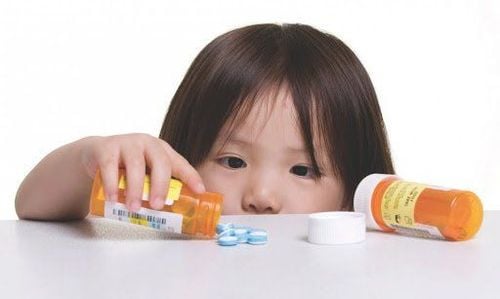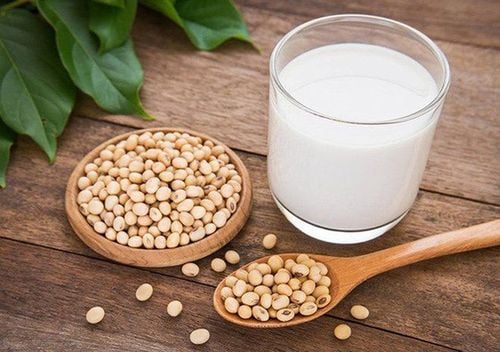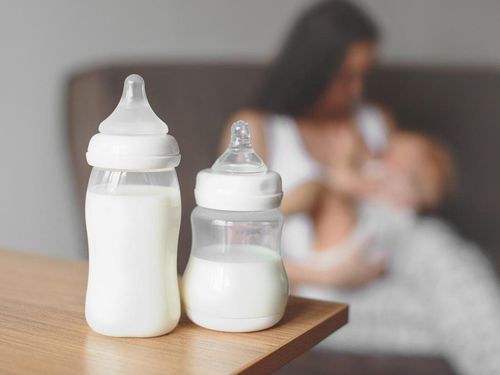This is an automatically translated article.
The article was professionally consulted by Doctor Nguyen Thai Ngoc Chau - Department of Pediatrics - Neonatology, Vinmec Phu Quoc International General Hospital.Any mother wants her baby to receive the purest and best from breast milk. But for a variety of reasons, such as a mother with little or no milk, she has to give her baby additional nutrients from formula. But the mother only followed the manufacturer's instructions without paying attention to other important principles.
1. Notes when making baby formula
1.1. Appropriate amount of formula From 5 days old - 3 months old, every day a healthy and full-term baby will need about 150ml of formula per kg of body weight. For example, a baby weighing 3 kg will need 450ml of formula per day. From 3 to 6 months old, every day, babies need about 120ml of formula per kg of body weight. From 6 to 12 months old, babies need about 90-120ml of milk per kilogram of body weight per day. Premature babies need more milk. At first, babies usually need about 160-180ml of milk per kilogram of body weight per day. However, parents need professional guidance before deciding what to do. If you are concerned about your baby's health and growth, the advice of a doctor is essential.1.2. Hygiene principles To prevent the accidental introduction of harmful agents into the baby's body, parents should pay attention to hygiene when mixing milk. First of all, please wash your hands thoroughly and make sure the preparation area is clean. Next, you need to make sure to check the expiration date of the formula. Milk should only be used within one month of opening the can.
Trắc nghiệm: Sự phát triển tinh thần, vận động của bé thế nào là đúng chuẩn?
Khi nào bé biết nói, biết hóng chuyện hay biết cầm cốc là "đúng chuẩn"? Điểm xem bạn biết được bao nhiêu mốc phát triển tinh thần, vận động "đúng chuẩn" của bé nhé!The following content is prepared under supervision of Thạc sĩ, Bác sĩ y khoa, Ma Văn Thấm , Nhi , Phòng khám Đa khoa Quốc tế Vinmec Dương Đông(Phú Quốc)
Pour the correct amount of boiling water into the bottle. Next, use the measuring spoon provided in the formula box to accurately and accurately measure the correct amount of powdered milk each time. The measuring spoon of each type of formula may be larger or smaller than other brands' products, but I never use a half spoon or a spoon, a spoon that is compacted. Mom just needs to scoop up a full spoon of milk and swipe it across. Then, pour the milk powder into the milk bottle already filled with water earlier, turn the screw cap, cover the outer cap and shake gently to dissolve the mixture.
Germs are easy to multiply in ready-to-eat milk, so mothers should only prepare milk right before giving it to babies. Do not mix 2-3 ready-made bottles. If going out during the day, the safest way is to store boiled water to cool and divide the required amount of formula in the milk divider. When needed for the baby to drink, it will be mixed into a new milk mixture.
When the milk carton is used up, mothers must throw it away with the measuring spoon included in the milk carton.
1.3.Warm milk for babies Mothers should never warm milk bottles in the microwave. Microwaves will heat the milk unevenly, which can create parts of the milk that are too hot to burn your baby's mouth.
Mothers can warm the bottle by soaking in a basin of hot water for about 10 minutes. In addition, before giving it to your baby, you should test the temperature of the milk by putting a little on the inside of your wrist. If it gets too hot, you can cool the bottle by running it under cool running water or by submerging it in a small basin of cool water. Remember to check the temperature on your wrist before giving it to your baby.
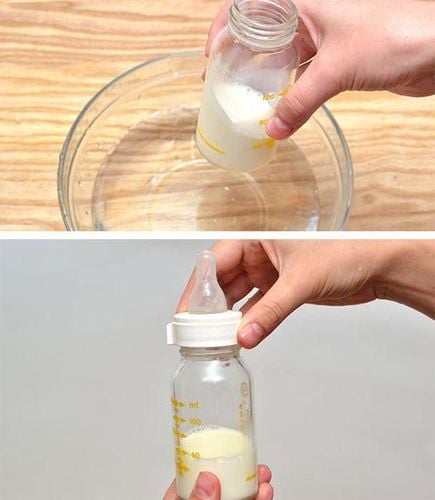
Mothers should not use reconstituted formula for more than 2 hours at room temperature.
1.5. Do not mix other foods Mothers do not arbitrarily add other foods, such as cereals to the bottle... If you think your baby needs to eat more than recommended, you should consult a professional to advice.
You may hear relatives or friends recommend adding something to your milk - usually vegetable juice or food - to help your baby gain weight or sleep better. Even though they say they've done it and have had good results, moms should know that every child is different and what is good for one child may not be good for another.
1.6. What water to use to make baby milk The water used to make baby milk must be boiled filtered water. It is not allowed to use water, purified water or mineral water for mixing. Many people think that using mineral water to make baby milk will be very good and convenient because it does not take the time to boil water. However, this will alter the nutrients contained in the formula.
In addition, the baby's digestive system is not as complete as an adult's, so it cannot successfully metabolize the minerals in mineral water. If you use mineral water to make baby formula, over time, stones will form in the kidneys.

1.8. Enjoying with your child Mealtimes are the time when people spend time together and socialize. Just like adults, children and babies love to talk while they are being “eaten”. When you give your baby formula, hold your baby close to you, let your baby see your face and whisper with him. This will be a very enjoyable experience for both mother and child.
Then, you need to put the bottle away as soon as the baby has had enough. Absolutely do not let the baby take the bottle alone and leave to let the baby fend for himself. This is very dangerous because the baby can choke. In the long run, the baby is also at risk of otitis media and tooth decay.
Infants and young children are two very sensitive subjects, the incorrect use of formula will affect the baby's digestive system and immature immune system later on. A healthy and well-developed child needs a good digestive system.
2. Instructions for making formula milk
Please note, you always need to:Wash your hands thoroughly and make sure that the preparation area is clean. Check the expiration date on the bottom of the box or on the package to make sure the powder is not expired. Mix all the milk within one month of opening the tin. After a month, discard the milk whether it is still or not. Follow the manufacturer's instructions strictly. Ensuring the correct amount of milk when mixing is very important to provide adequate nutrition for your baby. Boil clean water in a kettle or pot. Do not leave boiling water out at room temperature for longer than 30 minutes before preparing infant formula because hot water will help kill bacteria (pathogens) hidden in the formula. Pour the required amount of hot water into the bottle. Please use the spoon that comes with the milk carton to accurately measure the amount of powdered milk. A scoop of milk can be larger or smaller depending on the brand of milk. Never measure half a spoon as it may not be the exact amount of milk. Fill up the scoop volume instead and then pour the excess milk away.
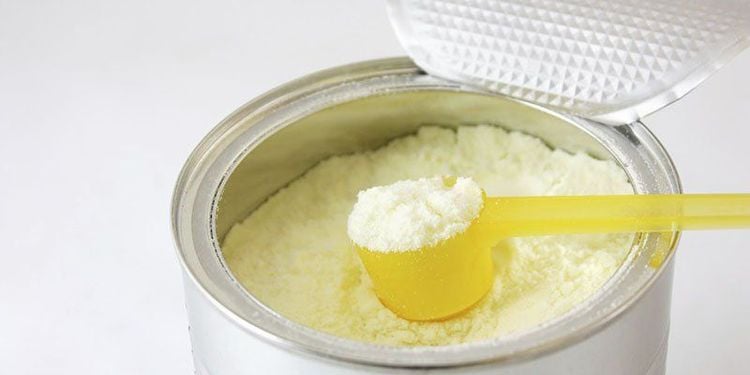
Test the temperature by putting some milk on your wrist and feel the temperature with your skin. If the milk is too hot, cool the bottle under cool running water or soak in a container of cool water. Remember to double check the milk temperature with your wrist before giving it to your baby. If you have to go out all day, bring hot water in a hot water bottle and formula, and then prepare it for your baby before he needs to drink. When the milk carton is empty, throw away the scoop with the milk carton. Read instructions carefully if you're changing brands of formula to make sure you're mixing the right amount of water and milk. Although breast milk is the best for babies, when conditions do not allow a mother to exclusively breastfeed her baby, formula milk can be used to ensure adequate nutrition, especially for babies. especially in the first years of life.
For children to be healthy and develop well, it is necessary to have a nutritious diet in terms of quantity and quality balance. If children are not provided with adequate and balanced nutrients, it will lead to diseases of excess or lack of nutrients, which adversely affect the comprehensive development of children in terms of physical, mental and motor skills.
The period of baby eating solid foods is an extremely important period to help children develop comprehensively. Children who do not eat properly are at risk of micro-mineral deficiencies, causing anorexia, growth retardation, malabsorption, etc. If they notice the above signs, parents should supplement their children with supportive products. The supplement contains lysine, essential micro-minerals and vitamins such as zinc, chromium, selenium, and B vitamins to help fully meet the nutritional needs of children. At the same time, these essential vitamins also support digestion, enhance nutrient absorption, help improve anorexia, and help children eat well.
Parents can learn more:
Signs of zinc deficiency in children
Micronutrient deficiency and failure to gain weight in children
Please regularly visit Vinmec.com website and update useful information to take care of your child. Take care of the baby and the whole family.







